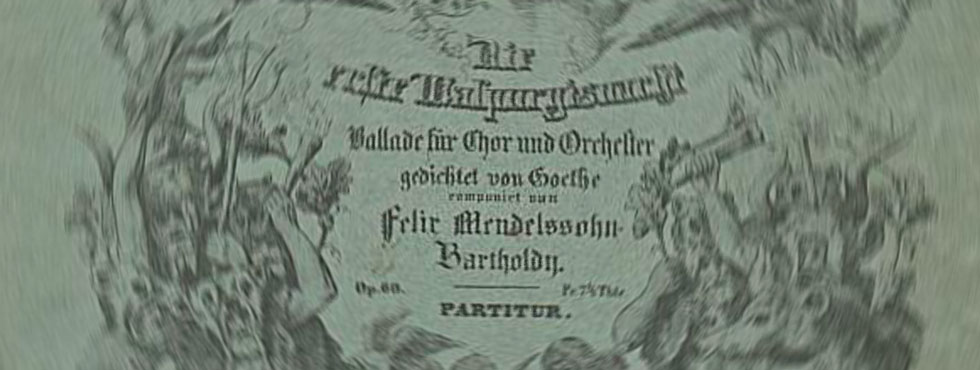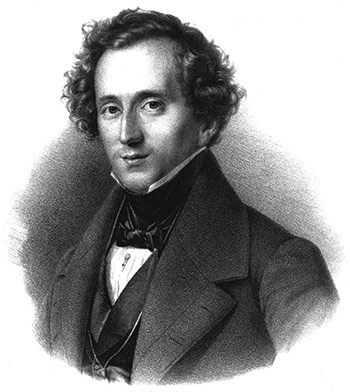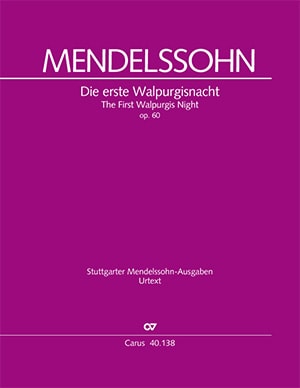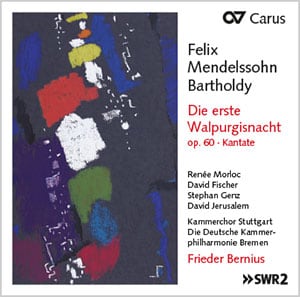Whirling Momentum
Mendelssohn’s colorful setting of Goethe’s ballad “Die erste Walpurgisnacht” (“The First Walpurgis Night”)
It is not a biblical story but pagan rituals which form the core of Mendelssohn’s composition based on a ballad by Goethe: the pagans stage a colourful spectacle to frighten off Christians, enabling the former to celebrate their annual Walpurgis Night ritual undisturbed. Goethe’s grotesque yet humorous portrayal of the conflict provided Mendelssohn with a vivid musical raiment.
Among the most consequential literary-musical relationships of the nineteenth century was Goethe’s decade-long friendship with Felix Mendelssohn Bartholdy. The prodigy was only twelve when in 1821 he accompanied his teacher, Carl Friedrich Zelter, to Weimar to meet the senescent doyen of German arts and letters. After Mendelssohn performed several of his own compositions and sight-read autographs of Mozart and Beethoven from his host’s library, Goethe shared this astonishing but reasoned evaluation: the young guest was nothing less than a “second Mozart.”
Before composing Die erste Walpurgisnacht Mendelssohn had already set a few of Goethe’s poems as Lieder or part-songs, but had also dedicated the imposing Piano Quartet No. 3 in B minor Op. 3 (1825) to the poet, and, according to the composer’s elder sister, Fanny, found inspiration for the whimsical Scherzo of the Octet Op. 20 in the “Walpurgisnachtstraum” scene from Faust, Part I. But by 1825 Mendelssohn had not yet envisioned what became by far his most substantial engagement with the poet’s verses, the cantata Die erste Walpurgisnacht Op. 60, for orchestra, chorus, and soloists, based, to be sure, not on the dream sequence in Faust but rather on a separate ballad in twelve stanzas about the Walpurgisnacht legend that Goethe had written as early as 1799. Goethe’s ballad treats the efforts of pagans gathering on the Blocksberg to outwit early Christian proselytizers and to preserve the ancient rites.
Goethe’s ballad concerns early medieval pagan rites in the Harz Mountains on May Eve. In Goethe’s reading, the revelries originated as a defense against Christian zealotry. Attempting to scare off “dumpfe Pfaffenchristen” (dimwitted Christian priests), the Druids masqueraded as satanic figures to rout their oppressors by conjuring up the Christians’ own “fabricated” devil. Goethe’s poem symbolized a recurring historical process – how something “old, established, tested, and reassuring” is repeatedly disarranged and displaced by innovation. Mendelssohn excerpted this comment by Goethe on the verso of the title page of the ballad.
F. Mendelssohn Bartholdy
Die erste Walpurgisnacht op. 60
scoring: Soli ATBarB (ATB), Coro SATB, Picc, 2 Fl, 2 Ob, 2 Clt, 2 Fg, 2 Cor, 2 Tr, 3 Trb, Timp, Gran Tamburo e Piatti, 2 Vl, Va, Vc, Cb
duration: 36 min
degree of difficulty: 1 2 3 4 5
Goethe had first dispatched the ballad to Zelter, his musical confidant in Berlin. Though Zelter expressed enthusiasm over the ballad, he was unable to make headway in setting it, and left the task to his student to complete. Mendelssohn started the composition on his journey to Italy in 1830. A stream of letters confirms that much of the composition indeed came together in the Eternal City, where Mendelssohn was somehow able to imagine and invent the colorful musical imagery for the Druids and their conflict on the fog-enveloped Brocken with the proselytizing, early Christian missionaries. On his way back from Rome he took the opportunity in Milan to play large swaths of the cantata to an unlikely auditor he met there, Carl Thomas Mozart, the eldest son of Mozart, who had the distinction of being “the only man who so far knows it, . . . and who was so pleased with it, that the familiar things also gave me new pleasure; he absolutely wanted me to publish it forthwith.”
Mendelssohn accomplished the work in early 1832, not long before the deaths of Goethe and Zelter. But, as was the case with many of Mendelssohn’s major works, the 1832 version of Die erste Walpurgisnacht was not to be the Fassung letzter Hand. Instead of releasing his manuscript after its Berlin premiere in January 1833, Mendelssohn set the work aside for a full decade. Then, returning to the score in 1842, he rewrote it “from A to Z,” subjecting the whole to a comprehensive, abecedarian revision, a process he described as a mixture of broad-brushed re-composition and more refined tailor’s work (“Schneiderarbeit”).
Mendelssohn directed the premiere of the revised version at the Leipzig Gewandhaus early in February 1843, and it subsequently appeared in print from the Leipzig firm of Friedrich Kistner, a little more than one year later.
Audio sample from CD Carus 83.503
Die erste Walpurgisnacht became one of Mendelssohn’s most successful choral works. Among its admirers was Hector Berlioz, who attended the Leipzig premiere in 1843, and recorded these impressions:
“One must hear Mendelssohn’s music to realize what scope the poem offers a skillful composer. He has made admirable use of his opportunities. The score is of impeccable clarity, notwithstanding the complexity of the writing. Voices and instruments are completely integrated, and interwoven with an apparent confusion which is the perfection of art. I would especially single out, as superb examples of two diametrically opposite genres, the mysterious scene of the posting of the sentinels and the final chorus, in which the voice of the priest rises solemnly and serenely at intervals above the din of the decoy demons and sorcerers. One does not know which to praise most in this finale, the orchestral or the choral writing, or the whirling momentum and sweep of the whole.”
Compact Disc Die erste Walpurgisnacht op. 60
Interpreters: Frieder Bernius, Kammerchor Stuttgart, Die Deutsche Kammerphilharmonie Bremen, Renée Morloc, David Fischer, Stephan Genz and David Jerusalem (soloists)
The recording also includes excerpts from Mendelssohn’s incidental music Oedipus at Colonos to Sophocles’ tragedy.







Leave a Reply
Want to join the discussion?Feel free to contribute!